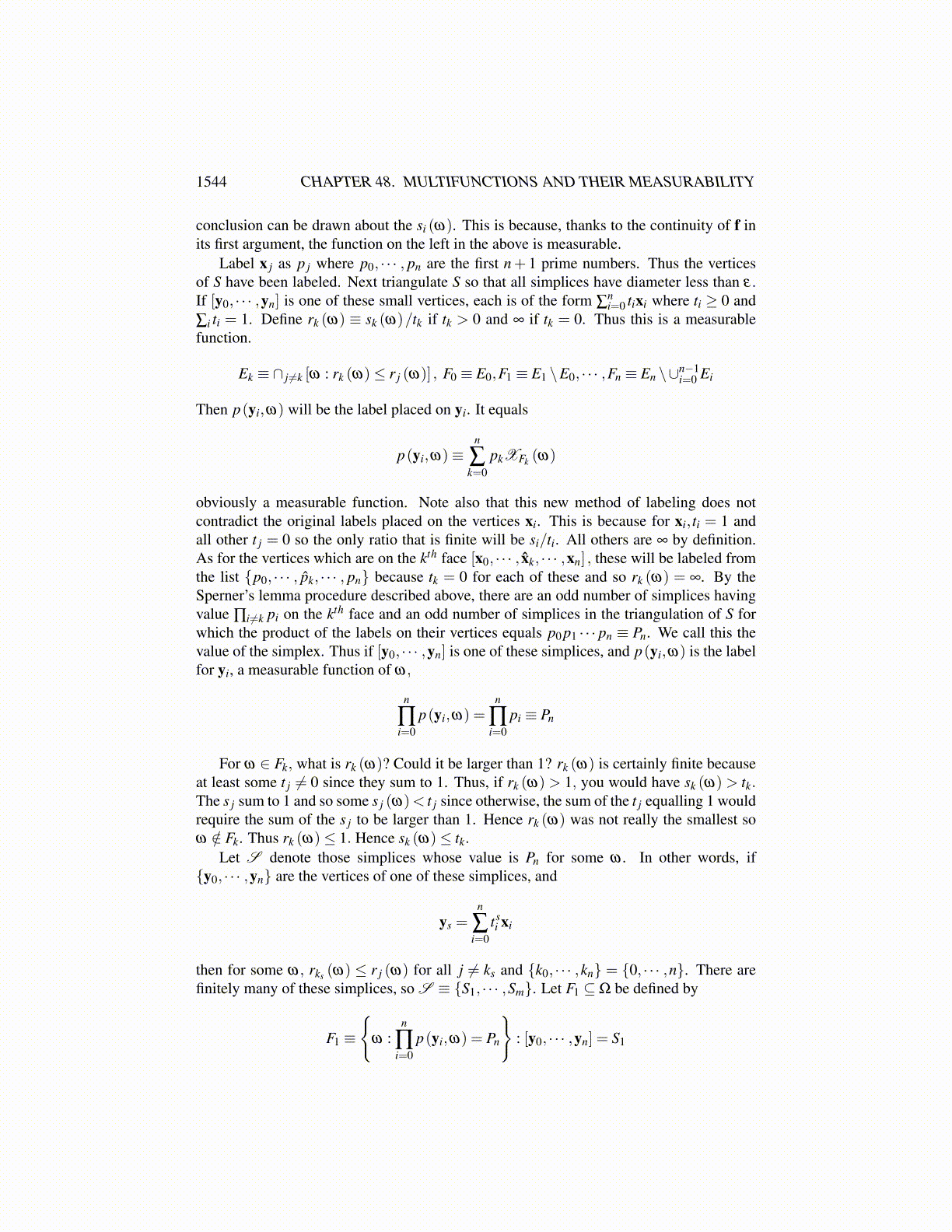
1544 CHAPTER 48. MULTIFUNCTIONS AND THEIR MEASURABILITY
basic open set in the topology of X . Thus let O = ∏∞i=1 Oi where each Oi is a proper open
subset of R only for i ∈ { j1, · · · , jm} . Then,
Γ−n (O) = ∪k≥n∩m
r=1{
ω :⟨z jr ,uk (ω)
⟩∈ O jr
},
which is a measurable set since uk is measurable.Then, it follows that ω → Γn (ω) is strongly measurable because it has compact values
in X , thanks to Tychonoff’s theorem. Thus Γ−n (H) = {ω : H ∩Γn (ω) ̸= /0} is measurablewhenever H is a closed set. Now, let Γ(ω) be defined as ∩nΓn (ω) and then for H closed,
Γ− (H) = ∩nΓ
−n (H)
and each set in the intersection is measurable, so this shows that ω→ Γ(ω) is also measur-able. Therefore, it has a measurable selection g(ω). It follows from the definition of Γ(ω)that there exists a subsequence n(ω) such that
g(ω) = limn(ω)→∞
h(un(ω) (ω)
)in X .
In terms of components, we have
gi (ω) = limn(ω)→∞
⟨zi,un(ω) (ω)
⟩.
Furthermore, there is a further subsequence, still denoted with n(ω), such that un(ω) (ω)→u(ω) weakly. This means that for each i,
gi (ω) = limn(ω)→∞
⟨zi,un(ω) (ω)
⟩= ⟨zi,u(ω)⟩ .
Thus, for each zi in a dense set, ω → ⟨zi,u(ω)⟩ is measurable. Since the zi are dense,this implies ω → ⟨z,u(ω)⟩ is measurable for every z ∈ U ′ and so by the Pettis theorem,ω → u(ω) is measurable.
There is an easy version of this which follows from the same arguments.
Corollary 48.2.3 Let K (ω) be a compact subset of a separable metric space X and sup-pose
{u j (ω)
}∞
j=1 ⊆ K (ω) with each ω → u j (ω) measurable into X. Then there existsu(ω) ∈ K (ω) such that ω→ u(ω) is measurable into X and a subsequence n(ω) depend-ing on ω such that limn(ω)→∞ un(ω) (ω) = u(ω).
Proof: DefineΓn (ω) = ∪k≥nuk (ω),
This is a nonempty compact subset of K (ω)⊆ X . I claim that ω→ Γn (ω) is a measurablemultifunction into X . It is necessary to show that Γ−n (O) defined as {ω : Γn (ω)∩O ̸= /0} ismeasurable whenever O is open in X . For ω ∈ Γ−n (O) it means that some uk (ω)∈O,k≥ n.Thus Γ−n (O) = ∪k≥nu−1
k (O) and this is measurable by the assumption that each uk is.Since Γ−n (ω) is compact, it is also strongly measurable by Proposition 48.1.4, meaningthat Γ− (H) is measurable whenever H is closed. Now, let Γ(ω) be defined as
Γ(ω)≡ ∩nΓn (ω)